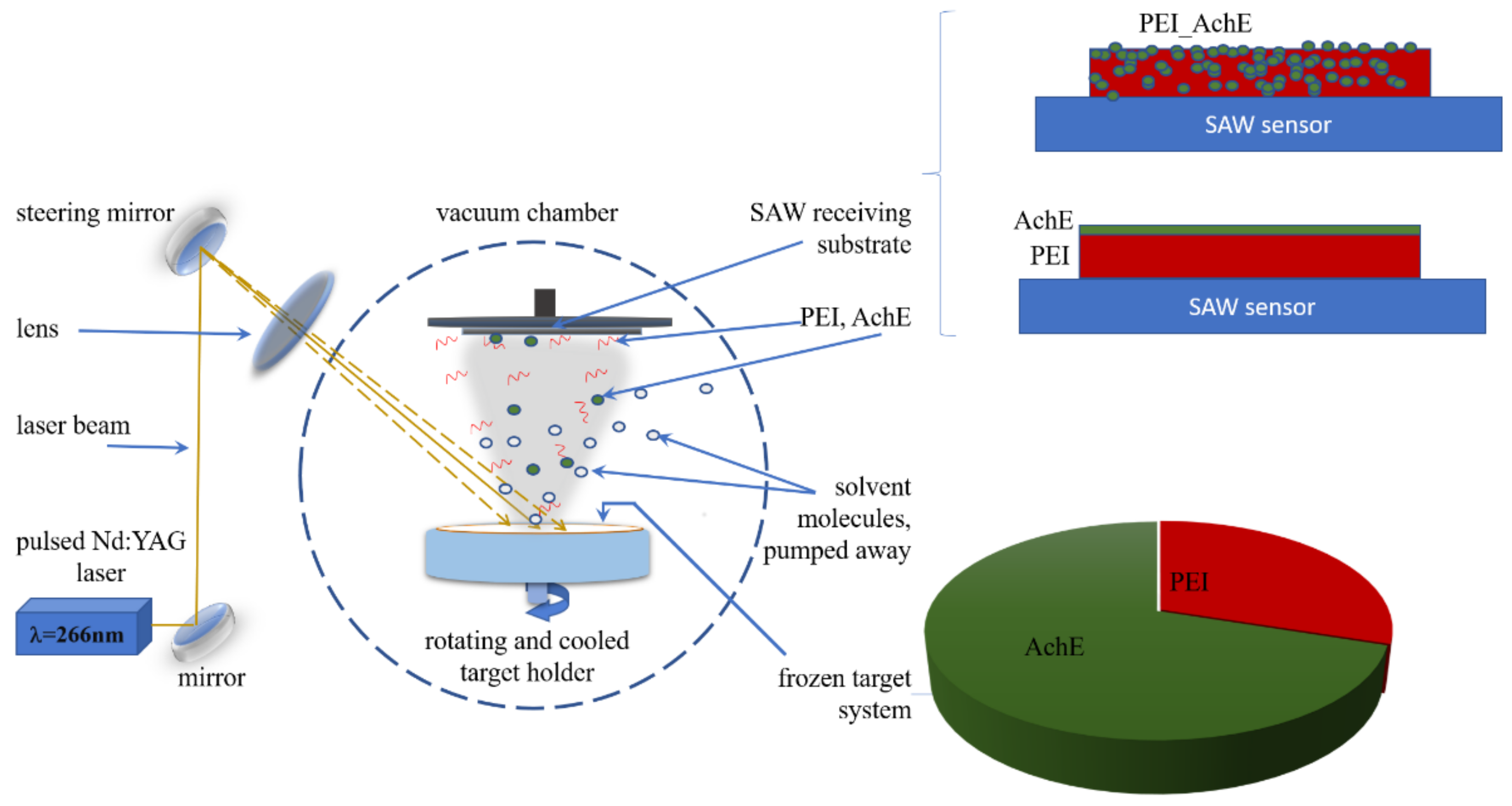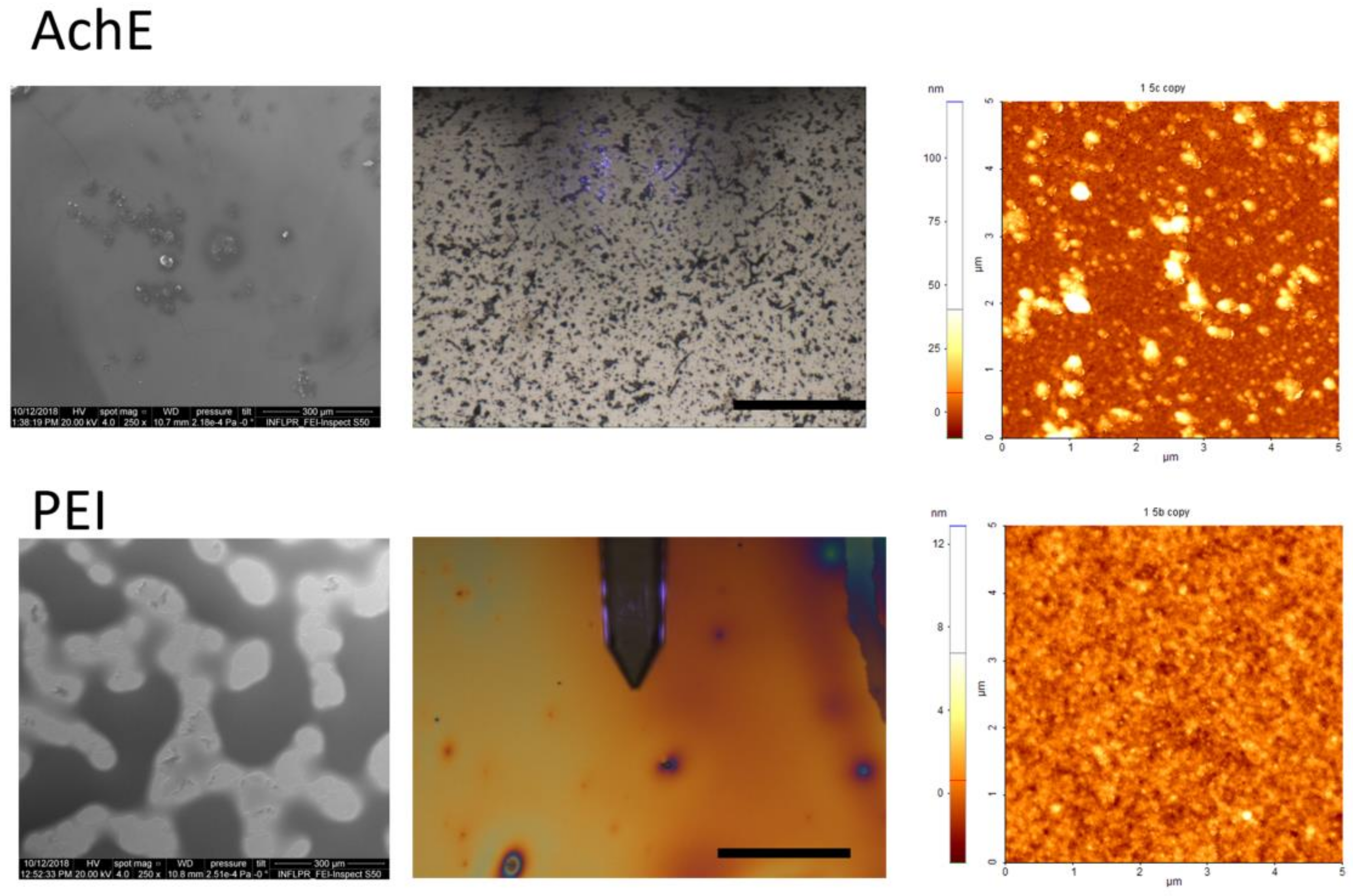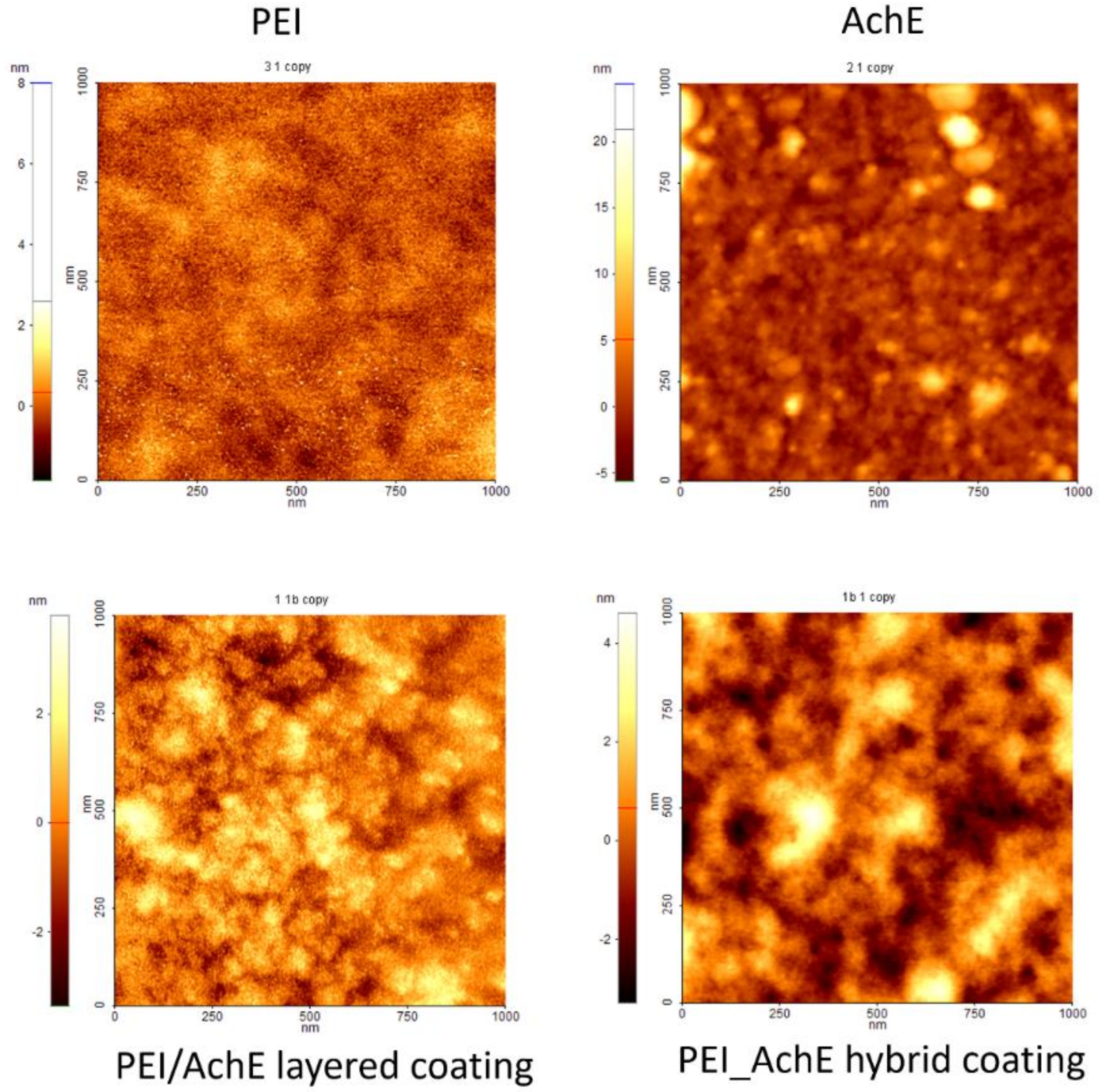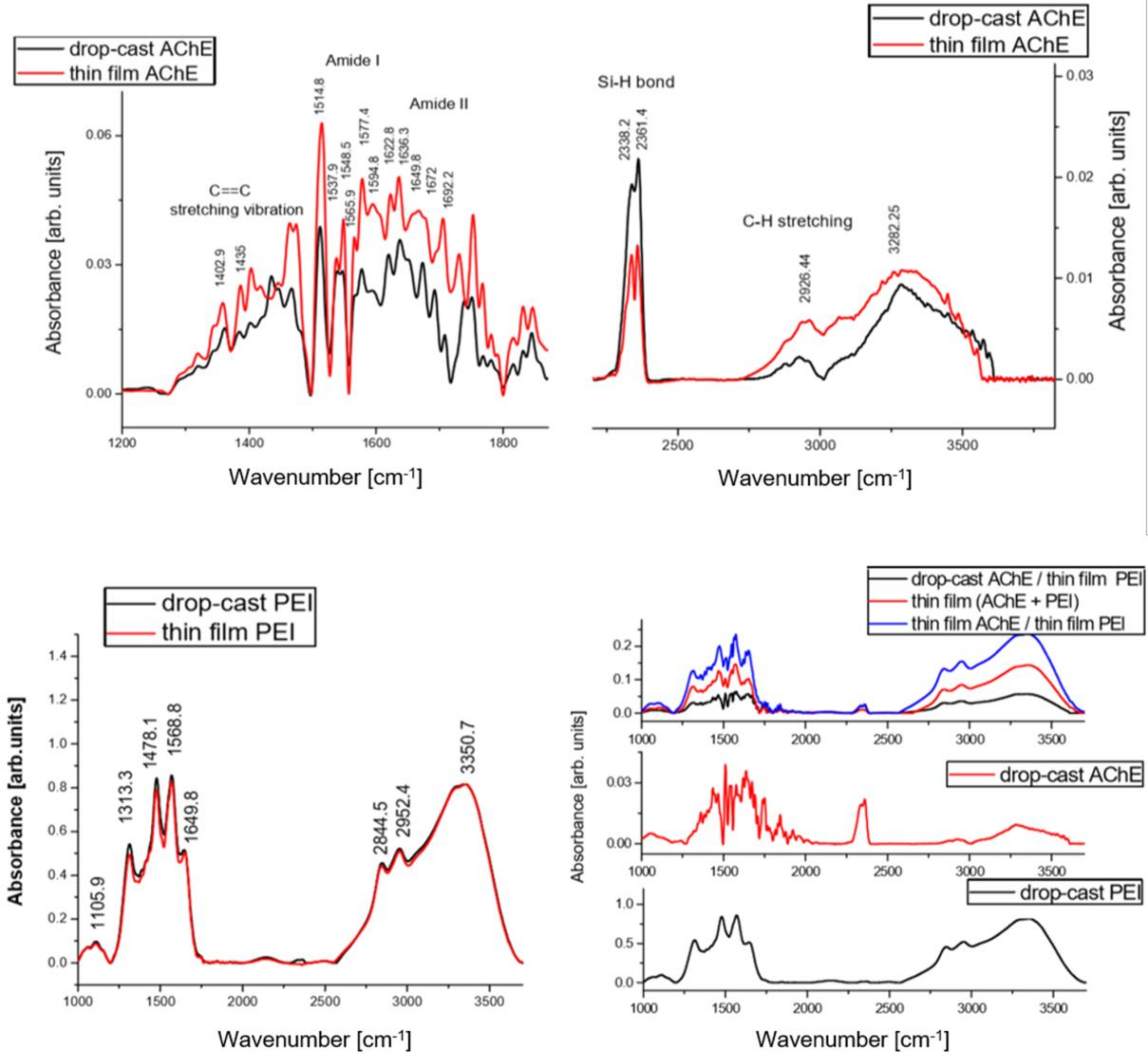MAPLE Assembled Acetylcholinesterase–Polyethylenimine Hybrid and Multilayered Interfaces for Toxic Gases Detection
Abstract
1. Introduction
2. Materials and Methods
2.1. Target Solutions Preparation
2.2. Matrix-Assisted Pulsed Laser Evaporation System
2.3. Substrate Preparation
2.4. Chemical and Morphological Characterization of the Deposited Thin Films
2.5. DMMP and DIMP Measurements
3. Results and Discussion
3.1. Morphological Characterization
3.2. Chemical Characterization
3.3. DMMP and DIMP Measurements
4. Conclusions
Author Contributions
Funding
Conflicts of Interest
References
- Viespe, C. Surface acoustic wave sensors based on nanoporous films for hydrogen detection. Key Eng. Mater. 2014, 605, 331–334. [Google Scholar] [CrossRef]
- Sil, D.; Hines, J.; Udeoyo, U.; Borguet, E. Palladium nanoparticle-based surfaceacoustic wave hydrogen sensor. ACS Appl. Mater. Interfaces 2015, 7, 5709–5714. [Google Scholar] [CrossRef]
- Phan, D.T.; Chung, G.S. Surface acoustic wave hydrogen sensors based on ZnO nanoparticles incorporated with a Pt catalyst. Sens. Actuators B Chem. 2012, 161, 341–348. [Google Scholar] [CrossRef]
- Peng, W.; He, Y.; Wen, C.; Ma, K. Surface acoustic wave ultraviolet detectorbased on zinc oxide nanowire sensing layer. Sens. Actuators A Phys. 2012, 184, 34–40. [Google Scholar] [CrossRef]
- Atashbar, M.Z.; Sadek, A.Z.; Wlodarski, W.; Sriram, S.; Bhaskaran, M.; Cheng, C.J.; Kaner, R.B.; Kalantar-zadeh, K. Layered SAW gas sensor based on CSA synthesized polyaniline nanofiber on AlN on 64◦YX LiNbO3 for H2 sensing. Sens. Actuators B Chem. 2009, 138, 85–89. [Google Scholar] [CrossRef]
- Al-Mashat, L.; Ahn, D.S.; Han, S.H.; Hong, W.G.; Shin, K.; Yoon, C.S.; Kalantar-zadeh, K.; Wlodarski, W. Layered surface acoustic wave hydrogensensor with nanoporous polyaniline as the active layer. Sens. Lett. 2011, 9, 73–76. [Google Scholar] [CrossRef]
- Varghese, O.K.; Gong, D.; Dreschel, W.R.; Ong, K.G.; Grimes, C.A. Ammonia detection using nanoporous alumina resistive and surface acoustic wavesensors. Sens. Actuators B Chem. 2003, 94, 27–35. [Google Scholar] [CrossRef]
- Rudel, R.A.; Perovich, L.J. Endocrine disrupting chemicals in indoor and outdoor air. Atmos. Environ. 2009, 43, 170–181. [Google Scholar] [CrossRef]
- Lin, Y.; Yan, Q.; Kong, C.; Chen, L. Polyethyleneimine Incorporated Metal-Organic Frameworks Adsorbent for Highly Selective CO2 Capture. Sci. Rep. 2013, 3, 1859. [Google Scholar] [CrossRef]
- Baker, K.L.; Bolger, F.B.; Lowry, J.P. A microelectrochemical biosensor for real-time in vivo monitoring of brain extracellular choline. Analyst 2015, 140, 3738–3745. [Google Scholar] [CrossRef]
- Singh, M.; Kaur, M.; Kukreja, H.; Chugh, R.; Silakari, O.; Singh, D. Acetylcholinesterase inhibitors as Alzheimer therapy: From nerve toxins to neuroprotection. Eur. J. Med. Chem. 2013, 70, 165–188. [Google Scholar] [CrossRef] [PubMed]
- Vandeput, M.; Parsajoo, C.; Vanheuverzwijn, J.; Patris, S.; Yardim, Y.; Le Jeune, A.; Sarakbi, A.; Mertens, D.; Kauffmann, J.-M. Flow-through enzyme immobilized amperometric detector for the rapid screening of acetylcholinesterase inhibitors by flow injection analysis. J. Pharm. Biomed. Anal. 2015, 102, 267–275. [Google Scholar] [CrossRef] [PubMed]
- Kurbanoglu, S.; Ozkan, S.A.; Merkoçi, A. Nanomaterials-based enzyme electrochemical biosensors operating through inhibition for biosensing applications. Biosens. Bioelectron. 2017, 89, 886–898. [Google Scholar] [CrossRef] [PubMed]
- El Harrad, L.; Bourais, I.; Mohammadi, H.; Amine, A. Recent Advances in Electrochemical Biosensors Based on Enzyme Inhibition for Clinical and Pharmaceutical Applications. Sensors 2018, 18, 164. [Google Scholar] [CrossRef] [PubMed]
- Yang, S.; Zhang, J. Matrix-Assisted Pulsed Laser Evaporation (MAPLE) technique for deposition of hybrid nanostructures. Front. Nanosci. Nanotech. 2017, 3. [Google Scholar] [CrossRef]
- Rusen, L.; Neacsu, P.; Cimpean, A.; Valentin, I.; Brajnicov, S.; Dumitrescu, L.N.; Banita, J.; Dinca, V.; Dinescu, M. In vitro evaluation of poly(ethylene glycol)-block-poly(ɛ-caprolactone) methyl ether copolymer coating effects on cells adhesion and proliferation. Appl. Surf. Sci. 2016, 374, 23–30. [Google Scholar] [CrossRef]
- Caricato, A.P.; Buonsanti, R.; Catalano, M.; Cesaria, M.; Cozzoli, P.D.; Luches, A.; Manera, M.G.; Martino, M.; Taurino, A.; Rella, R. Films of brookite TiO2 nanorods/nanoparticles deposited by matrix-assisted pulsed laser evaporation as NO2 gas-sensing layers. Appl. Phys. A 2011, 104, 963–968. [Google Scholar] [CrossRef]
- Dinca, V.; Florian, P.E.; Sima, L.E.; Rusen, L.; Constantinescu, C.; Evans, R.W.; Dinescu, M.; Roseanu, A. MAPLE-based method to obtain biodegradable hybrid polymeric thin films with embedded antitumoral agents, Biomed. Microdevices 2014, 16, 11–21. [Google Scholar] [CrossRef]
- Icriverzi, M.; Rusen, L.; Sima, L.E.; Moldovan, A.; Brajnicov, S.; Bonciu, A.; Mihailescu, N.; Dinescu, M.; Cimpean, A.; Roseanu, A.; et al. In vitro behavior of human mesenchymal stem cells on poly(N-isopropylacrylamide) based biointerfaces obtained by matrix assisted pulsed laser evaporation. Appl. Surf. Sci. 2018, 440, 712–724. [Google Scholar] [CrossRef]
- Mitran, V.; Dinca, V.; Ion, R.; Cojocaru, V.D.; Neacsu, P.; Dinu, C.Z.; Rusen, L.; Brajnicov, S.; Bonciu, A.; Dinescu, M.; et al. Graphene nanoplatelets-sericin surface-modified gum alloy for improved biological response. RSC Adv. 2018, 8, 18492–18501. [Google Scholar] [CrossRef]
- Rusen, L.; Brajnicov, S.; Neacsu, P.; Marascu, V.; Bonciu, A.; Dinescu, M.; Dinca, V.; Cimpean, A. Novel degradable biointerfacing nanocomposite coatings for modulating the osteoblast response. Surf. Coatings Technol. 2017, 325, 397–409. [Google Scholar] [CrossRef]
- Dinca, V.; Zaharie-Butucel, D.; Stanica, L.; Brajnicov, S.; Marascu, V.; Bonciu, A.; Cristocea, A.; Gaman, L.; Gheorghiu, M.; Astilean, S.; et al. Functional Micrococcus lysodeikticus layers deposited by laser technique for the optical sensing of lysozyme. Colloids Surf. B Biointerfaces 2018, 162, 98–107. [Google Scholar] [CrossRef] [PubMed]
- Viespe, C.; Grigoriu, C. Surface acoustic wave sensors with carbon nanotubes and SiO2/Si nanoparticles based nanocomposites for VOC detection. Sens. Actuators B Chem. 2010, 147, 43–47. [Google Scholar] [CrossRef]
- Viespe, C.; Miu, D. Surface acoustic wave sensor with Pd/ZnO bilayer structure for room temperature hydrogen detection. Sensors 2017, 17, 1529. [Google Scholar] [CrossRef] [PubMed]
- Marcu, A.; Nicolae, I.; Viespe, C. Active surface geometrical control of noise in nanowire-SAW sensors. Sens. Actuators B Chem. 2016, 231, 469–473. [Google Scholar] [CrossRef]
- Gorne-Tschelnokow, U.; Naumann, D.; Weise, C.; Hucho, F. Secondary structure and temperature behaviour of acetylcholinesterase Studies by Fourier-transform infrared spectroscopy. Eur. J. Biochem. 1993, 213, 1235–1242. [Google Scholar] [CrossRef] [PubMed]
- Hucho, F.; Naumann, D. Ute Görne-Tschelnokow, FTIR-Spectroscopic Investigations of the Structure and Temperature Stability of the Acetylcholinesterase from Torpedo californica. In Enzymes of the Cholinesterase Family; Springer: Boston, MA, USA, 1995; pp. 83–88. [Google Scholar]
- Khaldi, K.; Sam, S.; Gouget-Laemmel, A.C.; De Villeneuve, C.H.; Moraillon, A.; Ozanam, F.; Yang, J.; Kermad, A.; Ghellai, N.; Gabouze, N. Active acetylcholinesterase immobilization on a functionalized silicon surface. Langmuir 2015, 31, 8421–8428. [Google Scholar] [CrossRef]
- Raj, V.B.; Singh, H.; Nimal, A.T.; Tomar, M.; Sharma, M.U.; Gupta, V. Origin and role of elasticity in the enhanced DMMP detection byZnO/SAW sensor. Sens. Actuators B 2015, 207, 375–382. [Google Scholar] [CrossRef]
- Wang, F.; Liu, P.; Nie, T.; Wei, H.; Cui, Z. Characterization of a polyamine microsphere and its adsorption for protein. Int. J. Mol. Sci. 2013, 14, 17–29. [Google Scholar] [CrossRef]
- Saleem, M.; Rafiq, M.; Seo, S.-Y.; Lee, K.H. Acetylcholinesterase immobilization and characterization, and comparison of the activity of the porous silicon-immobilized enzyme with its free counterpart. Biosci. Rep. 2016, 36, e00311. [Google Scholar] [CrossRef]
- Du, X.; Ying, Z.; Jiang, Y.; Liu, Z.; Yang, T.; Xie, G. Synthesis and evaluation of a new polysiloxane as SAWsensor coatings for DMMP detection. Sens. Actuators B 2008, 134, 409–413. [Google Scholar] [CrossRef]
- Wang, S.; Li, Z.; Lu, C. Polyethyleneimine as a novel desorbent for anionic organic dyes on layered double hydroxide surface. J. Colloid Interface Sci. 2015, 458, 315–322. [Google Scholar] [CrossRef] [PubMed]
- Anslyn, E.V.; Dougherty, D.A. Modern Physical Organic Chemistry; University Science Books: Sausalito, CA, USA, 2005; ISBN 1-891389-31-9. [Google Scholar]
- Quiñonero, D.; Garau, C.; Rotger, C.; Frontera, A.; Ballester, P.; Costa, A.; Deyà, P.M. Anion-π interactions: Do they exist? Angewandte Chemie Int. Ed. 2012, 41, 3389–3392. [Google Scholar] [CrossRef]
- Kan, X.; Liu, H.; Pan, Q.; Li, Z.; Zhao, Y. Anion-π interactions: From concept to application. Chin. Chem. Lett. 2018, 29, 261–266. [Google Scholar] [CrossRef]
- Tripathi1, U.C. Srivastava, acetylcholinesterase: A versatile enzyme of nervous system. Ann. Neurosci. 2008, 15, 1–9. [Google Scholar]
- DeRuiter, J. Resonance and Induction Tutorial. Principles of Drug Action 1. Available online: https://www.auburn.edu/~deruija/pdareson.pdf (accessed on 3 December 2018).






| Position (cm−1) | Vibrations |
|---|---|
| PEI | |
| 3500 | NH asymmetric stretching |
| 3391 | NH symmetric stretching |
| 3365 | NH stretching II |
| 2915 | CH asymmetric stretching |
| 2881 | CH symmetric stretching |
| 1647 | N–H deformation |
| 1496 | C–H deformation |
| 1043 | C–N stretching |
| AchE | |
| 3282.25 | OH stretching |
| 2962 | C–H stretching |
| 2340; 2360 | Asymmetric stretching, CO2 gas phase influence |
| 1700–1600 | Amide I |
| 1600–1500 | Amide II |
| 1451–1410 1200−1405 1300 | C==C stretching vibration νC−N stretch νN−H bend |
| Sensor Type | DIMP | DMMP |
|---|---|---|
| Frequency Shift [kHz] | Frequency Shift [kHz] | |
| Multilayer PEI/AchE | 30 | 10 |
| PEI with AchE | 200 | 65 |
| PEI | 11 | 4 |
© 2018 by the authors. Licensee MDPI, Basel, Switzerland. This article is an open access article distributed under the terms and conditions of the Creative Commons Attribution (CC BY) license (http://creativecommons.org/licenses/by/4.0/).
Share and Cite
Dinca, V.; Viespe, C.; Brajnicov, S.; Constantinoiu, I.; Moldovan, A.; Bonciu, A.; Toader, C.N.; Ginghina, R.E.; Grigoriu, N.; Dinescu, M.; et al. MAPLE Assembled Acetylcholinesterase–Polyethylenimine Hybrid and Multilayered Interfaces for Toxic Gases Detection. Sensors 2018, 18, 4265. https://doi.org/10.3390/s18124265
Dinca V, Viespe C, Brajnicov S, Constantinoiu I, Moldovan A, Bonciu A, Toader CN, Ginghina RE, Grigoriu N, Dinescu M, et al. MAPLE Assembled Acetylcholinesterase–Polyethylenimine Hybrid and Multilayered Interfaces for Toxic Gases Detection. Sensors. 2018; 18(12):4265. https://doi.org/10.3390/s18124265
Chicago/Turabian StyleDinca, Valentina, Cristian Viespe, Simona Brajnicov, Izabela Constantinoiu, Antoniu Moldovan, Anca Bonciu, Constantin Nicolae Toader, Raluca Elena Ginghina, Nicoleta Grigoriu, Maria Dinescu, and et al. 2018. "MAPLE Assembled Acetylcholinesterase–Polyethylenimine Hybrid and Multilayered Interfaces for Toxic Gases Detection" Sensors 18, no. 12: 4265. https://doi.org/10.3390/s18124265
APA StyleDinca, V., Viespe, C., Brajnicov, S., Constantinoiu, I., Moldovan, A., Bonciu, A., Toader, C. N., Ginghina, R. E., Grigoriu, N., Dinescu, M., & Scarisoreanu, N. D. (2018). MAPLE Assembled Acetylcholinesterase–Polyethylenimine Hybrid and Multilayered Interfaces for Toxic Gases Detection. Sensors, 18(12), 4265. https://doi.org/10.3390/s18124265










